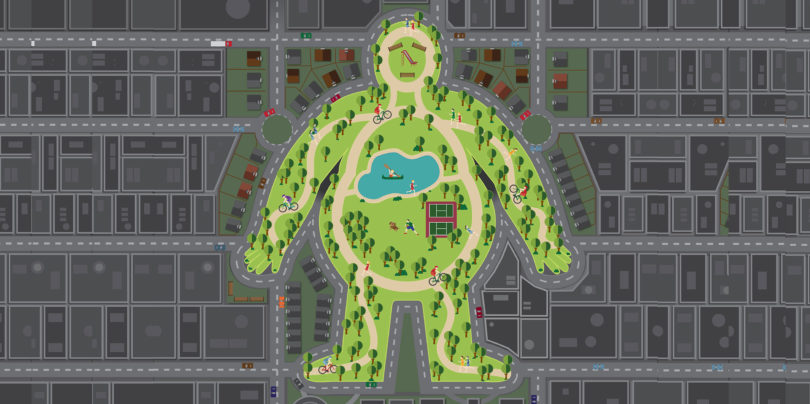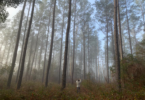The United States wants to be a world leader – just not in obesity rates. But until last year, America was No. 1 in what has become a public health epidemic.
The Centers for Disease Control and Prevention states that more than a third of American adults are obese. And we’re passing this unhealthy living on to our children, with one in six kids now classified not just as overweight, but obese.
It’s an alarming problem that public health experts are treating as an epidemic. How do we get Americans to be more active and lose weight? What is the key to controlling the obesity problem in America?
Building more parks would probably help, Warnell researchers say. In a recent study, Drs. Ramesh Ghimire and Gary T. Green examined the Body Mass Index (BMI) and its relationship to available green space in the U.S. And what their research found is that places with forests, public recreation lands, and outdoor recreation resources have lower obesity rates than areas without those same opportunities.
That may have seemed like an obvious conclusion, but it’s not something that has been extensively examined in detail, Ghimire said, and previous studies treated all green space the same. It’s more nuanced than that, he explained, particularly when considering the nonobvious factors that public health experts say contribute to obesity, such as socioeconomic status, education level, demographic characteristics, and barriers to physical activity.
But how people use the outdoor recreation opportunities available to them is also influenced by things like weather and topography, Ghimire said, which complicates that relationship. It’s an important topic to study. Last year, Mexico took over the No. 1 spot from the U.S. as the fattest country in the world, but 2016 rankings haven’t been released yet when The Log went to print.
“The prevalence of overweightness and obesity has increased at an alarming rate over the past decades,” Ghimire said, “and obesity is a major public health concern.”
The link between green space and healthy living
The link between public open space and healthy lifestyles has been fairly anecdotal, Ghimire said, and few studies really looked at the relationship between the two. Obesity rates have been rising for decades despite the numerous programs and initiatives like “Healthy People 2020” that have been launched to combat this problem.
Cutting back on calories isn’t the only thing we need to do, Ghimire said. We also need to improve access to outdoor recreation opportunities and green spaces.
Ghimire and Green’s study focused on making distinctions between the types of green space available to the public and found that accounting for those differences matters: BMI is significantly lower in counties across the U.S. with large amounts of forestland, whereas those places with lots of pastures and cropland don’t see the same lower body weight. They distinguished four types of green space: Forestland, pastureland, rangeland and croplands, and considered the proximity to national and state parks. This was a change from previous studies done by others. “We do not know why they treated all green space indistinctly, but all green space should not be treated the same,” Ghimire said.
They used BMI data from the 2012 Behavioral Risk Factor Surveillance System from the CDC, which compiled information about adults over the age of 18 living in the United States, Guam, the U.S. Virgin Islands and Puerto Rico.
They took into account a number of factors that could affect their results, including the characteristics of the people in the study, and compared individual BMI rates to county-wide statistics. They controlled for factors like income, ethnicity, education, age and even environmental factors.
Some of their findings:
— The BMI of residents living in counties in close proximity to state and national parks, outdoor recreational resources, recreation facilities, and better natural or environmental facilities is “significantly lower” than those counties without these same green spaces nearby.
— Distinguishing the types of green space available to the public matters, and researchers should treat them as distinct from each other when studying their impacts on body weight and public health.
— A different study estimated that increasing BMI by just one unit increases the public health cost by $6 billion every year. Using that estimate, Ghimire and Green calculated that increasing forestland by one acre per capita across the U.S. would help lower BMI, and could thus lower public health costs by $3 million a year.
— Many of the Mountain and Pacific states like California, Colorado and Utah had much lower obesity rates. “They are also richer in public open space such as public parks and other outdoor resources,” Ghimire said.
— However, the Southern states had higher obesity rates, “where public parks and other outdoor recreation resources are relatively fewer, compared to the Mountain and Pacific states,” he said.
— Approximately 720 million people visited state parks in 2014, and 292 million visited national parks. And more than half the counties included in their study have at least one state park within its boundaries.
— BMI was significantly higher in counties with greater disparity in incomes and higher poverty levels. These places “tend to have fewer safe places to walk and play, fewer shops offering affordable, healthy food, and widespread advertisements for unhealthy food and beverages.” Ghimire and Green’s paper notes that poverty also contributes to unhealthy eating because healthy diets actually cost more than unhealthy food opportunities. But making public access to parks more available in these areas might help. “Opening new public parks and other recreation facilities in the neighborhoods and making these parks more accessible to people, particularly to those with low socioeconomic status, may help improve their weight outcomes,” the study says.
Get outside, get moving
Public health experts argue the obesity issue in America cannot simply be blamed on people eating too much. It is a complex problem that began decades ago. Studies have shown that as a nation’s economy grows, obesity often comes with it – and it’s the poor who are at the most risk of being obese. Those with higher incomes can lead healthier lives, exercise regularly and afford to eat healthier, while those living in poverty may resort to eating cheaper, unhealthy food and have limited access to places where they can be physically active.
Although this study did not look at childhood obesity rates, weight gain in kids is also a complicated problem. Kids today do not go outside as much as previous generations – spawning programs such as No Child Left Inside to spur environmental awareness in children – but the CDC points to other causes behind childhood obesity: the rampant advertising of and greater availability of unhealthy food, increasing portion sizes, access to high calorie sugary drinks, and lack of physical activity.
Also important to this problem, the CDC says on its website, is that there is “no safe and appealing place, in many communities, to play or be active … half of the children in the United States do not have a park, community center and sidewalk in their neighborhood.”
Obesity is related to the leading causes of death, including heart disease, cancer, stroke and diabetes, and it is costing $147 billion in medical costs ever year in the U.S. It’s why initiatives like Healthy People 2020 exist.
This study, Ghimire said, shows that having more parks and preserving forests and increasing easy access to public recreation lands would help reduce the collective BMI of the U.S. But to do that, we would need to improve forest infrastructures, like road accessibility, educational walking paths and hiking trails, and preserving the unique characteristics of the forests that would draw people there in the first place.
We also need to change people’s perceptions about using public parks, Ghimire said, and there also needs to be a push to open more public parks or open green spaces in deprived neighborhoods. “BMI is significantly higher in communities with low socioeconomic status,” he explained.
“Being obese is more than a personal decision,” Ghimire said. “Limited or no access to natural areas also plays a role in people becoming overweight and obese.”
— Sandi Martin, Warnell School of Forestry and Natural Resources, from the Spring 2016 issue of The Log.






